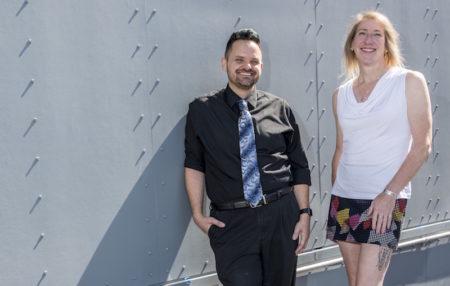By Keri Troutman
Tom Gallant was one of the earliest members of Berkeley Lab’s Lambda Alliance, but he had no idea why lambda was the symbol for the LGBTQ community. After getting a lot of questions about it, he did a little research and found an answer that intrigued him.
He discovered that a 1970s graphic designer had chosen the Greek letter lambda as the symbol of a gay activism group specifically because of its meaning in chemistry and physics. Within the STEM field, the lambda symbol is associated with the half-life parameter of exponential random variables, which describes the time it takes for a state to change. “Now I can point people to a whole section on our website FAQ, because what I found out was so interesting,” says Gallant, a Principal Administrator in the Nuclear Science Division.
The lambda was officially declared the international symbol for gay and lesbian rights in 1974 and has been used in the official names of many LGBTQ associations since. “I thought it was so fitting that the name of our organization would also have a scientific reference,” says Gallant, who chairs the Lambda Alliance along with Amanda Krieger, an integrated circuit designer in the Engineering Division.
The Lambda Alliance, an official Lab Employee Activities Association (EAA), was formed with the mission to “enhance the work environment for lesbian, gay, bisexual, transgender, intersex, queer, and questioning employees, and allies by promoting an inclusive and welcoming atmosphere, supporting policies of non-discrimination, identifying and addressing emerging issues or challenges, increasing visibility and awareness, and celebrating achievements impacting our community.”
Coffee, movies, and allies
“The main thing for Lambda Alliance is to be a place where people can come and talk and be with like-minded people who they feel comfortable with,” says Gallant. “We host a coffee hour at the Lab every month, and everyone is welcome.”
In addition they also host a monthly after-work happy hour and other networking and social events. Last year they coordinated a series of events for Pride Month – a resource fair, a networking reception, and movie screenings – after which they saw membership grow from 55 to 145. He adds that a lot of those new members are allies, or folks who don’t identify as LGBTQ but want to support their friends, family members, and coworkers.
Krieger notes that allies play a key role in furthering policy issues. “The more people show up, the more accountability there is,” she says. “Allies are the diplomats for our community. It is the underlying philosophy of civil rights that unites us all.”
She adds: “One of my early mentors in advocacy liked to say, ‘Diversity is being invited to the party; inclusion is being asked to dance.’”
Before there was Lambda Alliance there was a precursor social organization. Gallant had joined that organization when he first started at Berkeley Lab in 2000, but activities had dwindled over the years until it was “resurrected” in 2013 by Lady Idos, senior analyst for the Diversity and Inclusion Office (DIO), and former Lab employee Andrea Mercado.
First-ever workplace gender transition guidelines
As the Lambda Alliance grew stronger, it became clear that policy and advocacy were important issues for the group, says Gallant. In 2015 it formed the Lab’s first Employee Resource Group (ERG), with the goal of focusing a smaller group of members on specific policy issues.
Amanda Krieger and Susan Synarski, a program operations analyst for the Energy Technologies Area, co-chair the ERG. Its first big task was drafting a set of workplace gender transition guidelines, adopted by Berkeley Lab in June 2016.
“We’d had a couple of transgender employees transition at work, and they described it as basically ‘a scavenger hunt without a map,’” says Idos. “We wanted to give them a roadmap for managing all the bureaucratic changes, as they have enough to worry about with just managing relationships.”
Krieger was instrumental in getting the guidelines implemented and has served as a resource for other transitioning employees. “When I transitioned at the Lab four years ago, I felt supported but I had to really pioneer the way through all the complexity of that process,” she says.
Berkeley Lab is the first among the UC campuses and DOE Labs to adopt official workplace gender transition guidelines. Berkeley Lab was also behind the formation of National Lab Pride last year; it now has 67 members from 13 national labs.
The ERG is now working on more policy issues, including looking at the Human Rights Campaign’s corporate accountability index, which is basically a measure of how LGBT-friendly a workplace is.
“A corporate climate survey is the first step with this,” says Krieger. “If we don’t know where we stand, we cannot make a path to where we want to be. We want to be a resource for our management so that we can see the Lab’s commitment to diversity implemented. We would like to see our org charts and leadership reflect the diversity we are committed to striving for.”
This month, the Lambda Alliance has an added task, which is putting up the rainbow flag each morning at the entrance to Berkeley Lab. “Driving into the Lab every day during Pride Month and seeing the flag there means a lot to me,” says Gallant. “It shows the Lab’s commitment to tolerance, because that’s really what the rainbow flag represents—it stands for unity and tolerance.”
Click here for a listing of Lab-wide Pride Month events.


